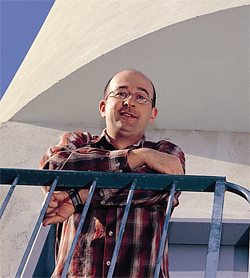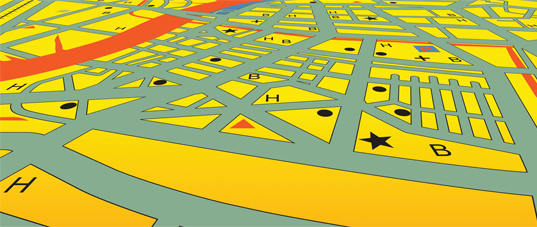"Our memories are basically who we are," says Dr. Nachum Ulanovsky of the Department of Neurobiology at the Weizmann Institute of Science. "I suspect that this is why people are so afraid of the various memory dysfunctions—because if you lose your memory then, in some way, you lose your identity and personality."

Dr. Nachum Ulanovsky
Dr. Ulanovsky investigates memory using an unconventional subject: bats. In addition to shedding light on the basic function of the memory system, his work could lead to new understanding of a range of neurological conditions. "There are dozens and dozens of disorders of the brain," he says, "and these are some of the most difficult medical problems to tackle."
Bats, which navigate freely and precisely, are well-suited to memory research because they have outstanding memory capabilities, including spatial memory. They also have a brain structure that is remarkably similar to our own, including the hippocampus, which plays a major role in episodic and spatial memory. "The hippocampus is an ancient structure," says Dr. Ulanovsky. "It developed long ago, and so is anatomically very similar across all mammals, including bats and humans."
Episodic and spatial memory are crucial to navigation, as they allow us to remember day-to-day events and information about the environment and our place in it. People and animals with no hippocampus are unable to form new memories or find their way around, and it is involved in conditions such as Alzheimer's disease, epilepsy, and schizophrenia; in fact, says Dr. Ulanovsky, "it's probably the most important brain region in terms of implications in various brain disorders."
"Some of the most difficult problems that medicine faces today have to do with the brain," says Dr. Ulanovsky. "Bats are already generating fresh views on the brain and memory."
Dr. Ulanovsky, who pioneered the use of bats in studies of hippocampal function, works with a species known as the Egyptian fruit bat (Rousettus aegyptiacus). He chose this bat from the approximately 1,250 varieties in the world because it is common in Israel; it echolocates, or uses sound (sonar calls) to navigate; and it is large—much larger, in fact, than any bat species in North America or Europe, which gives Dr. Ulanovsky a globally unique opportunity to put substantial research equipment on his bats, including miniaturized GPS and sophisticated neural telemetry recording systems.
He is able to take advantage of the bats' echolocating ability in his specially designed lab, which includes dark rooms that are large enough for the bats to fly in and have highly sensitive environmental controls. The lighting system, for example, enables him to literally switch the bats from one sense to another with the touch of a button, causing them to go from using their eyes to using their echolocation systems to navigate.
When the bats are searching for a target by echolocating, the rate of sonar calls is slow. When they detect a target and want to approach it, the calls become more rapid. As an experimenter, Dr. Ulanovsky finds this very convenient, since he "can simply put out a microphone and the animal literally tells you what it thinks."

For some targets the bats use a focused, high-intensity sound beam, whereas for other targets, they use a side-to-side, off-center beam to sweep the area in question. This research led to the finding, published in Science, that "looking" indirectly at an object, rather than straight on, may be the best way to find it.
While Dr. Ulanovsky's lab setup is extraordinary, so is the equipment he designed to study the animals in the wild. He created the world's smallest GPS devices, weighing just 10 grams, which the bats wear in tiny backpacks. The bats also have microelectrode implants that measure brain activity and transmit signals via a neural-telemetry wireless recording system, also the world's smallest and also developed by Dr. Ulanovsky. The research team is thus able to measure the bats' flight patterns and neural behavior as they fly freely, either in the lab or in the countryside.
The GPS data clearly show that while bats have some personal preferences—for example, one subject likes to visit a particular fruit tree, passing over others of the same type—their routes are direct and efficient, time and again, as they find their favorite foods and then return home. Even more remarkably, Dr. Ulanovsky was able to determine that bats have a "large-scale map-like memory," or cognitive map, which has long been suspected to reside in the hippocampus. Says Dr. Ulanovsky, this is "the first time a cognitive map, which is what enables the bats to navigate, has been shown in any mammal." This finding was recently published in the Proceedings of the National Academy of Sciences.
Bats and humans have similar brain structures, including the hippocampus and entorhinal cortex, which are involved in conditions such as Alzheimer's disease, epilepsy, and schizophreia.
As a result of the lab-based neural-telemetry studies, Dr. Ulanovsky and his group were the first to identify place cells (neurons that respond when the animal passes through a certain area of the environment) in the bat hippocampus. He also studies the entorhinal cortex of bats—a brain region adjacent to the hippocampus—and found there "grid cells," neurons that fire in a remarkable lattice-like or grid-like hexagonal pattern that resembles the hexagons of a honeycomb. Dr. Ulanovsky's findings on place cells and grid cells were published in the prestigious journals Nature and Nature Neuroscience.
He states, "Some of the most difficult problems that medicine faces today have to do with the brain." To fundamentally address the most complex brain disorders, scientists need a more nuanced understanding of how our brains work. "I have hope that understanding the function of these memory systems, especially by comparing them across mammalian species, will help solve the dysfunctions that arise," says Dr. Ulanovsky. "Bats are already generating fresh views on the brain and memory."
Dr. Nachum Ulanovsky's research is supported by the Nella and Leon Benoziyo Center for Neurological Diseases; the Clore Center for Biological Physics; the Irving B. Harris Foundation; the Estate of Fannie Sherr; Mr. and Mrs. Steven Harowitz, San Francisco, CA; and the European Research Council.
